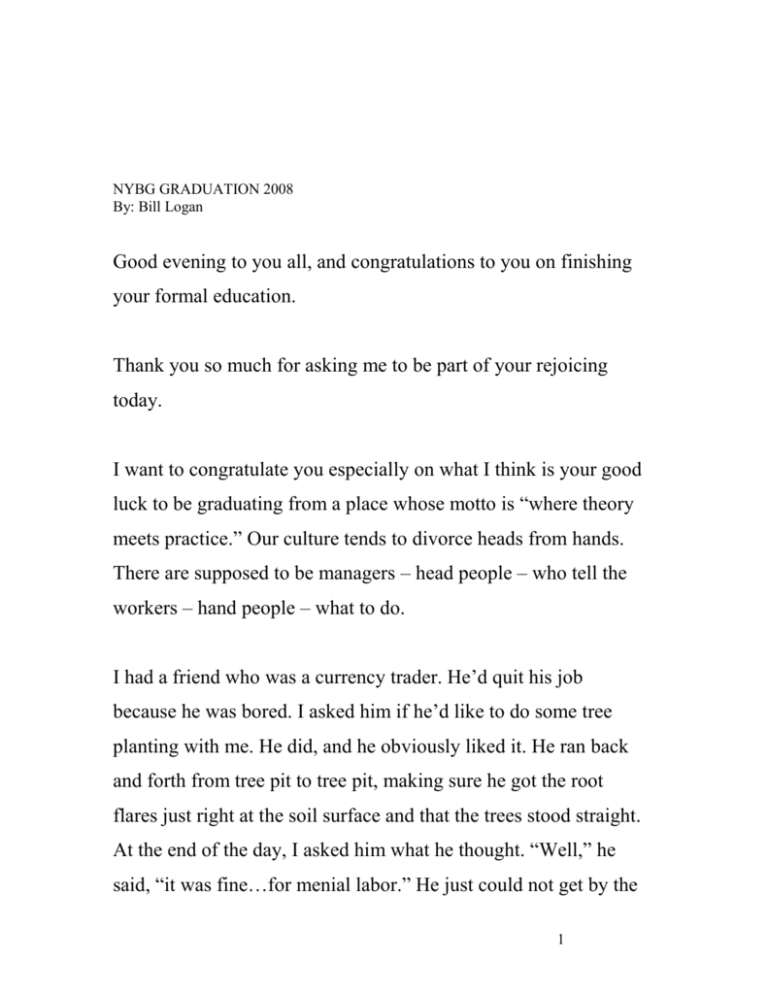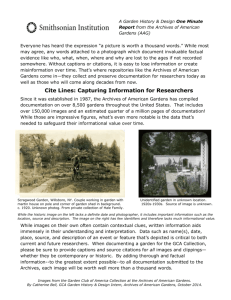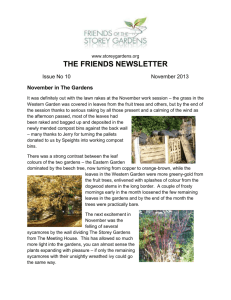NYBG Graduation Speech
advertisement

NYBG GRADUATION 2008
By: Bill Logan
Good evening to you all, and congratulations to you on finishing
your formal education.
Thank you so much for asking me to be part of your rejoicing
today.
I want to congratulate you especially on what I think is your good
luck to be graduating from a place whose motto is “where theory
meets practice.” Our culture tends to divorce heads from hands.
There are supposed to be managers – head people – who tell the
workers – hand people – what to do.
I had a friend who was a currency trader. He’d quit his job
because he was bored. I asked him if he’d like to do some tree
planting with me. He did, and he obviously liked it. He ran back
and forth from tree pit to tree pit, making sure he got the root
flares just right at the soil surface and that the trees stood straight.
At the end of the day, I asked him what he thought. “Well,” he
said, “it was fine…for menial labor.” He just could not get by the
1
notion that if you work with your hands you are somehow a lesser
person.
I think that the opposite is true. The meeting of mind and hand
makes hominids into human beings. When we work
directly with the resistant materials of the world, we learn
practical imagination, patience, receptivity, adaptability.
We learn to collaborate with the beautiful and the useful.
What finer gift can there be for an active mind and an open
heart?
The great medieval architect Hugh Herland made the roof
of Westminster Hall out of 660 tons of oak. He cut the
joints one by one, and laid the whole building out on the
ground before they raised it. And I think it likely any
common joiner or barn builder of his day – men who often
couldn’t read or write – understood what he was doing
better than did Richard II’s courtiers.
2
Not that the hard work involved in horticulture (or
anything else) is necessarily always fun or rewarding in
itself….
I understand, for example, that after your time at the
Garden you may have some very particular feelings about
violas. One source told me you have had to plant 10,000 of
them in a season. The next person said 20,000. I suspect if
I’d a room full of Horticulture students, I might have
ended up with estimates over 100,000!
And then of course, all the violas have to be dead-headed.
And then you have to pinch the yellowed leaves.
Give me theory, and the hell with practice, you think!
3
Someone else described to me the pleasures of doubledigging. The idea is indeed delightful. You scoop out a
hole at the start of your trench, loosen the subsoil, then
you shovel the topsoil from the next hole onto the gap in
the first hole, maybe mixing in compost. And so on and so
forth.
It’s the so on and so forth that makes you tired, sore,
blistered and cranky. Especially if it goes on from day to
day.
Rest assured that this situation is likely to continue.
Horticulture is just full of jobs that HAVE to be done.
I remember the first time I pruned a group of neglected
willow oaks. It was about this time of year. The wind was
rising. Drizzle was falling. And I discovered that day that
pruning the deadwood from mature willow oaks is like
4
trying to scratch a porcupine’s back. I didn’t like even a
moment of it.
But to this day, when I pass those trees, I admire them.
They still look completely different than they did and than
they would have had I not pruned them.
Once I asked the farmer and writer Wendell Berry why he
farmed, given that so many of the jobs involved things like
shoveling shit or killing sick birds or fixing clogged
drains. “Farming”, he said, “is the best education I ever
had. And the bad jobs usually don’t last very long.”
And then we go on to some completely different task. One
of the great things about our work with nature -- whether
we are farmers or gardeners – is that it involves many
different jobs. One moment, I may be looking at Childe
Hassaam’s paintings of Celia Thaxter’s flower garden, or
5
at Bonnard’s drawings of the trees in his garden. The next,
I am turning the compost. One moment, I reflect on the
history of apple culture and the origin of the apple tree in
present Kazakstan. The next moment, I am trying to horse
a brush hog along a side slope. One moment, I am
considering why the twig extension is declining on this
suffering red oak. The next, I am swearing at a balky
chainsaw.
We are not just trading money until we drop, or even
performing open heart surgery until we drop. We plant, we
imagine, we prune, we tend, we watch, we shape, we bring
water to a place or we carry it away… Our work is
inclusive, not exclusive. We are generalists by profession.
And we wait upon the pleasure of nature.
This is a good thing for people like you and me, because
we bring so much to gardens from our other pursuits. For
6
me, since I was a boy, I loved two things: poetry and
mountains. When I was to go to college, my grandfather
offered to pay for the whole thing, so long as I studied
forestry. Well, I chose poetry. I am not at all sorry that I
did. Somehow, though, in spite of myself, I have ended up
in trees.
I will tell you how it happened. I was a garden journalist. I
had to write about pruning. Someone told me the person to
talk to was a fellow named Wayne Cahilly. I called Mr.
Cahilly, who agreed to talk to me provided I would climb
a tree with him. (Wayne says he told his partner Ed Roy,
“Hey Ed! Looks like we caught ourselves a journalist!”)
When Wayne and I stood at the base of a big oak near
Azalea Way, he put a rope end in my hand, and I started to
tie knots in it, knots I no longer knew the names of, but
that I had used as a rock climber twenty years before. We
spent several hours fifty feet up that oak. At the end I
7
asked Wayne if we could do this again. Sure, he said,
when? I answered How about tomorrow? And so on and
so forth. Within a year, I was out of journalism and into
trees.
When I made that choice, I thought I ought to stop writing,
but I didn’t. Strangely, my work in trees has made it
possible for me to write more and I hope better than I ever
did before, though I must say I now love to write about
dirt and oaks and the way fungi cross oceans on the wind.
I was startled when I read your biographies, because I had
thought I was a special case, learning one thing and then
doing another. I guess that that is not true. Jamie brings
mechanical engineering and biology to horticulture. Leslie
brings architecture, and she knows how to build a bicycle.
Conn is a musician and holds a Masters degree in Russian
8
literature. Madeline is an art historian and a librarian.
Raelene is an herbalist, Ann Marie a biologist.
I want to encourage you to bring all that – along with all
the rest of your passions and wishes – to the work you are
now beginning. Who know where it will lead you? Who
knows how Russian literature will prove important to a
woodland garden? Or bicycle building to a fountain? Or
mechanical engineering to a hillside path? Or
microbiology to a garden of decomposers?
For the beauty of a garden or a landscape has at least three
sources, not just one.
The three I think of are Art, Science, and Work.
When one of them is present, we are happy. The three tend
to lead to one another. And when all three are present at
once, we experience a moment that never dulls or dims.
9
For example, I had to drive to Sunnyside Gardens in
Queens to prune some trees in a park. I turned a corner and
started up a hill. Halfway up, I saw before me a perfect
double allee of London planes making a tunnel down a
common New York Street. The proportions were as good
any in France. It was a work of art.
Science lets the strangeness into beauty. I personally find
it unutterably beautiful when an old tree with a hollow
begins to root into the compost it makes of itself right
inside the hollow. That the cambium can generate roots
aloft de novo I find interesting in the abstract, and
beautiful in the seeing.
As to the beauty that comes from work, John Brinckerhoff
Jackson used to say that gardens were not at all about Recreating Eden, as so many garden books insufferably
10
intone. Rather, he said, they were about work shared with
family and friends. Well, maybe not work on the violas,
but I will bet that you can each remember some moment in
your field work where a friendship was strengthened in
doing the job, and the results of the work made that
moment visible.
And all three together? Once, I went to Springfield,
Illinois to write a story about Jens Jensen’s Lincoln
Memorial Gardens. It was late October. Nobody seemed to
be able to tell me exactly where the garden was.
The sun was westering when I got there at last. From the
outside it looked like an ordinary woodland. “Where’s the
garden?” I wondered.
But as I walked down the pathways, I suddenly realized
that I was walking through rooms, each a grove of several
11
hundreds of trees: the beech room, the sugar maple room,
the burr oak room, the hornbeam room. The sun lit each
one according to the nature of the trees. The carpet under
my feet was the leaves of each species in each room. The
sun lit the floors and the canopies alike. There were
several stone circles in clearings at the nodes among
rooms, places to sit around a fire. And as I walked, I read
in the brochure that this garden had been made during the
Depression by Jensen, the local ladies’ club and the Boy
Scouts, to reclaim eroded and abandoned farmland. The
science, the art, the making….All I have to say to myself
is Lincoln Memorial Gardens, and I stand there again.
So bring everything you have to your work, never stop
learning, and don’t be afraid to make mistakes. I know that
that is easy to say, and hard to do. But in gardens and
landscapes, we have to have that attitude ON PRINCIPLE.
Because we cannot know how what we begin will turn out.
12
And we cannot learn all there is to know. IN PRINCIPLE.
Though we must bring to our work the best we have of
science, art and effort, we do not control the results, any
more than we can control the weather. Every mistake,
every uncertainty, is an opportunity to wonder, to discover
and to change the way we work. {can talk about girdling
roots in tree pits. Or Shigo and CODIT.}
Edward Lorenz proved it. After World War II, it was
thought that though we could not control the weather, we
could at least predict it accurately…two, three, four weeks
into the future. With the right climatic parameters and the
right computer program, why not?
Lorenz was working on it. He printed out one long range
forecast. It took half an hour for the computer to do this in
those days. To get a second print-out, he had to enter the
data again and wait for it to print. To save a little
13
computing time, he rounded off each number he entered at
the fifth or sixth digit after the decimal point. Then he
went for coffee.
When he came back, he was startled to find that the two
forecasts were different. They started off close enough for
a few days into the future, but by two weeks into the
future, they bore no resemblance to one another.
He must have made a mistake in data entry? No.
The computer must be busted? No.
What, then?
This apparent mistake was the beginning of the science of
complexity. Lorenz realized in that moment that neither he
nor anyone else would ever be able to predict the weather
14
two weeks into the future. There were too many variables
to ever account for. There is just too much world, and the
mind cannot encompass it. A butterfly flapping its wing in
Brazil could cause a hurricane in Miami. A man coughing
in China could make a blizzard in New York. The old
weatherman’s saying turned out to be true: “Climate is
what you expect, but weather is what you get.”
Our gardens and our landscapes are not written on paper or
painted on canvas or carved in stone. They become part of
the world of lived experience. When Jensen saw those
gullied, stony farm fields, he may well have thought, “We
haven’t got a chance to make a forest out of this! But let’s
try it anyway.” Thank goodness they did.
So here we stand on the cusp of spring. The temperature
is rising. The buds are swelling. You are leaving here and
15
going out into your lives. Who knows what will come of
it?
You have seen it all happen before. The bud scales bend
back. The leaves unfurl. The bulbs poke up their heads and
open.
Only this time, you will start to put your hand to it. And
your head and your heart. You will be a participant.
Good luck to you all, and again congratulations!
16








